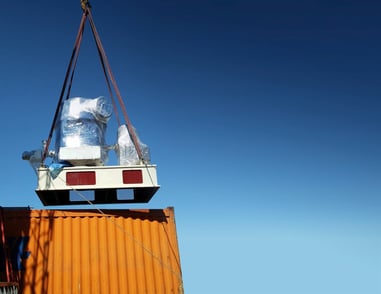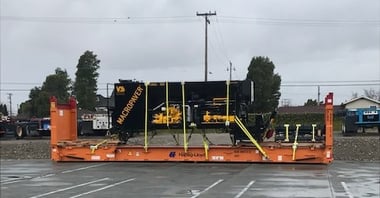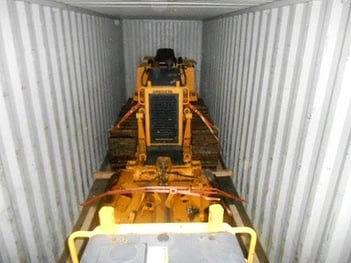OPEN TOP
 An open top container is exactly that – instead of having a solid roof, the top is open and can be covered with a soft covering. It is meant to carry oversized loads that can't be loaded from side doors or in a regular-sized shipping container. It must be loaded from overhead using a crane. An open top container still has accessible side doors for flexibility. Some open top containers, called hard top containers, have removable steel roofs.
An open top container is exactly that – instead of having a solid roof, the top is open and can be covered with a soft covering. It is meant to carry oversized loads that can't be loaded from side doors or in a regular-sized shipping container. It must be loaded from overhead using a crane. An open top container still has accessible side doors for flexibility. Some open top containers, called hard top containers, have removable steel roofs.
Downside: open top containers won’t accommodate wide loads.
FLAT RACK
 The flat rack container has collapsible walls at the front and back but is open on the sides and the top. Although it costs more than a standard container, it’s the right choice for an extra-wide load. It’s also one possible choice for a load that’s too long or tall for a standard container.
The flat rack container has collapsible walls at the front and back but is open on the sides and the top. Although it costs more than a standard container, it’s the right choice for an extra-wide load. It’s also one possible choice for a load that’s too long or tall for a standard container.
Obviously, you have to secure the load properly on a flat rack. Since this container is open on top and at the sides, you’ll also need protection against the elements. Depending on what you’re shipping, you might, for example, use tarps or shrink wrap or place crates around the cargo. Some self-propelled or towable machinery, such as construction equipment, might travel on a roll-on/roll-off (RoRo) ship instead of a container ship. Check out our article on choosing between flat rack or RoRo.
THE PLATFORM
Companies choose platform cargo boxes by process of elimination. Made from a steel frame and a wooden floor, they are used for cargo that can’t be transported via other container options. The structure has an extremely high loading capacity and provides a strong base for extremely heavy and bulky cargo, like machinery.
Why Does Oversized Cargo Cost More?
Yes, shipping OOG costs more. When you use a specialized container for shipping out of gauge cargo, the shipping line typically adds $250 or $500 to your bill. And that’s just for the container, not the load itself. You’ll pay even more if your oversized cargo takes up more than one slot on a container vessel. For instance, if a load sticks out two feet on either side of a flat rack, the shipping line can’t fit a container immediately to the left or right. If the load extends several feet above the walls of an open container, the line can’t stack another box on top.
At least, that’s what they tell you. Most oversized cargo actually travels in the top layer of containers, where stacking isn’t an issue, or else it travels under deck. Oversized freight might not take up any extra slots at all, depending on where it’s stowed, but the line will still charge a premium to ship it.
Sorry.
Many marine terminals charge higher handling fees for oversize containers than for conventional boxes. RoRo terminals also impose handling charges. You probably won’t see those terminal fees itemized on any invoice. Usually, the steamship line includes them in its total rate for shipping the container.
You’ll also pay more to transport this cargo over the road. In the U.S., loads that exceed standard height or weight restrictions need special permits, which come with a fee and certain conditions. Depending on the freight’s dimensions, you might have to conduct a route survey before a state issues the necessary permits. You might also have to hire an escort vehicle. Size restrictions and permit requirements vary from state to state and city to city, so various legs of the trip might need different arrangements. Check out our article on permit requirements for OOG cargo.
When you use a flat rack or open top container to transport an oversize load from the port to its final destination, you need to return that container to the port. So you’ll pay the trucking company for a round trip, even though it’s transporting your cargo only one way.
If the drayage isn’t far, the return trip won’t cost much. But if you need to move an oversize load from the Port of Newark to Pittsburgh, you might consider transloading the cargo onto a specialized chassis and leaving the container at the port.
Best Practices for Shipping Oversized Loads
With all the built-in extra costs of out of gauge cargo shipping, you need to look for ways to keep total costs under control. We’ve spent nearly 40 years doing just that. Here are a few tips on best practices for shipping machinery and other OOG cargo.
Make the load smaller
 If you can reconfigure your freight so that it fits into a container, that’s the best solution of all. Here are a couple of examples.
If you can reconfigure your freight so that it fits into a container, that’s the best solution of all. Here are a couple of examples.
- When a large machine arrived at a warehouse and was too wide to load as planned, we discovered that if we detached the axles and wheels before loading, everything would fit in a standard container. The shipper gave permission to cut some brackets with a blowtorch and, as a result, the shipper avoided the extra expense of flat rack or RoRo service.
- It can be much cheaper to disassemble and reassemble equipment on either end of an international shipment than to use a non-standard ocean container or ship via RoRo. Shipping a machine like this bulldozer in a standard container saves 50%+ on ocean transportation. Even with the cost of disassembly/reassembly, you’ll come out way ahead.
Give your logistics partner accurate information
Say you’ve told your third-party logistics provider (3PL) that your load is 120 inches tall and 110 inches wide. But when the trucker arrives to pick it up, he finds that it’s actually 128 inches tall and 120 inches wide. You might need to redo your permits, delaying the delivery and costing you extra money. This happens more often than you’d think!
Leave the conveyance at the port
Unless the final destination is close to the port, arrange to transfer your cargo from its open top container, flat rack or platform to a truck chassis. Otherwise, the trucker will charge you for returning the empty conveyance to the port.
Secure and protect heavy machinery
Whatever container you use, if the machinery doesn’t fully fill it, the load might shift and suffer damage in transit. You can use lumber to fill the empty space, plus straps, and maybe chains, to keep the cargo in place.
If you use a flat rack container, you must be extra careful about preparing the load for the voyage. Oversize cargo on a flat rack must pass an inspection at the port to make sure it’s blocked and braced according to standards set by the National Cargo Bureau (NCB). Fail inspection, and you’ll have to pay someone to rework the cargo before the steamship line will load it on the vessel.
Choose a trucker that specializes in OOG cargo
Most trucking companies don’t transport oversize cargo. Others might tell you they can handle the load, but do they have the equipment needed to move your freight safely, legally and cost-efficiently? Do they understand OOG cargo permit requirements? Do they know how to perform a route survey to avoid hazards such as low overpasses? A trucking company that doesn’t have solid experience with out of gauge loads could steer you toward all kinds of trouble – cargo damage, transportation delays or highway accidents that might land you in court.
Ensure proper weight distribution
According to a federal requirement called the Bridge Gross Weight Formula, the more an oversize load weighs, the longer the chassis you need to put under it, with more axles underneath. The aim is to distribute the weight so it doesn’t exert a damaging amount of force on the highway. When the truck transporting your OOG freight pulls into a weigh station – even if the trucker’s permit shows the right dimensions and weight – if that weight isn’t distributed correctly over the axles, an inspector will pull it off the road.
Buy from a location that makes sense
If your seller is located in eastern Pennsylvania, transporting the machine to a port on the East Coast for shipping to Europe is not all that expensive. But if the seller is in Kansas, that’s a more complicated and costly proposition. Ideally, when you’re shipping excavators and other large construction machinery, it’s most economical to buy from a place that is close to an ocean port. Figure out the cost of transportation to the port before you make your purchase. If the numbers don’t add up, look for a similar product in a better location.
Keep it clean
If you’re moving earth moving equipment internationally, even a few streaks of mud on the undercarriage could get your shipment turned away. It’s not that the inspectors are clean freaks; they’re just following regulations to keep invasive species from hitching a ride into their country. So when you buy construction equipment in the US, before you have the cargo loaded for shipping overseas, arrange for a pressure wash to get rid of all traces of dirt and debris.
OOG cargo shipments are often part of crucial shipping projects where the equipment must be in the right place at the right time. Check out our article on project cargo freight forwarders for advice on project cargo challenges and how the right forwarder can help.
CASE STUDY: OOG Shipping Without the Pain
Sometimes the best solution for transporting out of gauge cargo is to contact an expert. That’s why one manufacturer in Poland did. Here are the details (read the full case study).
THE CHALLENGE
A manufacturer in Poland arranged through an equipment broker to buy a huge CNC (computer numerical control) machine used to process wood, metal or other materials. The used system, owned by a company in Maine, cost about $105,000. The oversized cargo, once crated, was about the size of a large excavator. The buyer had to figure out how to get the machine out of the factory in Maine, pack it safely for the overseas trip, book it on a ship, get it to a port, retrieve it from the port in Poland and then transport it to the company’s own facility.
No one at this Polish company knew how to pull off such a complex move, so it placed a call to I.C.E. Transport’s office in Gdynia, Poland, which coordinated with I.C.E.’s US office to arrange the door-to-door move.
MAJOR STEPS IN THE JOURNEY
- C.E.’s U.S. office hired a rigging company in Maine to remove the machinery from the seller’s factory. The company brought portable cranes, forklifts and all the other equipment needed to lift the machinery out of the building and load it on a truck for transportation to the rigging company’s warehouse.
- The company built a crate just big enough for the cargo, with no wasted space, using lumber that was heat-treated to guard against invasive insects.
- A permit was obtained for the next leg of the journey to I.C.E.’s warehouse in Edison, NJ and an OOG specialist trucker was brought in to transport the cargo.
- C.E. coordinated with a second trucking partner that sent a driver to the Port of NY/NJ for a 40’ flat rack container, then used an overhead crane to load the crate onto that equipment.
- Workers blocked, braced and lashed the load onto the container according to NCB standards and the container arrived at the port, passed inspection and was loaded onto the ship, where it made an uneventful ocean crossing.
- In Poland, I.C.E. Transport’s customs office in Gdynia provided the paperwork needed to clear the load through Customs.
- The I.C.E. Transport office in Gdynia arranged for a trucker to deliver the flat rack container to the buyer’s facility, where the buyer had the CNC machine unloaded and installed.
It would have been theoretically possible for the Polish company to coordinate all these steps, but with little knowledge of OOG shipping and no knowledge of specialist transportation partners in the U.S., managing the project in-house would have been a very risky choice.
Mistakes to Avoid When Shipping Out of Gauge Cargo
Here are 5 common OOG cargo shipping mistakes we’ve seen in our many years managing such moves.
1. Providing the wrong information on dimensions and weight
Detailed specifications for your load are crucial at two points in the shipping process. The first is when you ask for a quote. Truckers who are willing and able to haul project cargo are few and far between. And they’re picky. The trucker who says yes to a 129’ load might back out when he discovers that the length is actually 131’. The second point is when he arrives to pick up. If the numbers on the permits don’t match the actual dimensions and weight, your trucker might have to tear up those permits and file for new ones, delaying the load and costing you money.
2. Forgetting to supply technical drawings or handling instructions
Crews that lift project cargo on and off a ship or truck can’t just guess where to connect their equipment. You need to direct them to the correct lift points and indicate the center of gravity. Otherwise, your load might tip, or make a piece of equipment tip, causing a dangerous, expensive accident. That’s why you should give your transportation partner technical drawings, with lift points and center of gravity clearly marked, plus handling instructions.
3. Skimping on insurance coverage
The cost of marine cargo insurance doesn’t come anywhere near the amount you’d pay to replace a damaged product. And don’t count on carriers to manage your risk, even if an accident is their fault. When you load a container with $500,000 worth of machinery, and then that load gets damaged in transit, it’s likely the carrier will pay only $500 for the loss. Rates vary with the type of machinery, but the more your load is worth, the smarter it becomes to purchase your own marine cargo insurance.
4. Giving vague instructions about necessary equipment
When a trucker arrives to pick up or drop off a shipment, you get one or two hours to load or unload before overtime charges kick in. If you’re shipping a container, that’s no big deal: you might pay $100 for an extra hour. But for project cargo, the hourly charge will be more like $400 or $500. So be very clear with everyone concerned about the need to stay on schedule.
5. Automatically choosing the cheapest route
The Advantages of an Experienced Freight Forwarder When Shipping Out of Gauge Cargo
Project cargo freight forwarders can provide outsized advantages when you’re shipping out of gauge cargo overseas. If you’re not part of a large organization, and you don’t ship this kind of equipment all the time, then you probably don’t have staff who know how to:
- secure and protect the load
- find truckers that specialize in overweight and/or oversize loads
- classify the machinery correctly to clear Customs
- arrange for transportation in another country, especially if no one in your company speaks the local language
When you ship oversized project cargo, there’s a lot at stake, and plenty that can go wrong if you lack experience with such shipments. Forwarders with OOG shipping expertise minimize your risk. Many are one-stop shops. They’ll take charge of your equipment from origin to final delivery, figuring out the best way to ship your load, secure qualified transportation partners, handle permitting and documentation, and track progress through every step.
Need help with regular out of gauge cargo shipments? Contact one of the OOG shipping specialists at I.C.E. Transport.